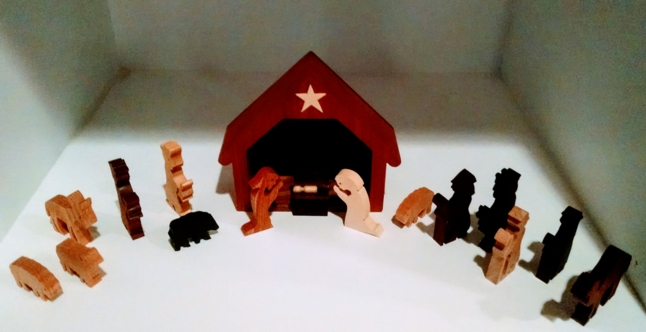Manger Story by Charlie

This beautiful manger arrangement was a gift to me in 2012 and the story that accompanies this creation is a treasure. Eternally thankful for my friend, Charlie Nelson.
The creche itself is made from walnut and cherry. Walnut, the darker wood, is considered the most valuable furniture and cabinet wood of the native North American hardwoods and the piece found in your creche was probably harvested from an Indiana forest. Cherry is the red colored wood and is known to grow best in the Appalachian region, although large stands of it exist in Indiana forests. It ranks second in value, only to walnut, as a furniture wood. However, its relative scarcity and popularity among wood workers has, at times, made it more expensive to buy than walnut. Cherry smells great while cutting it, much like you imagine wild cherry should smell, like the way a piece of cherry candy would smell. The cradle is made of wenge.
Mary is made from holly. I love the symbolism here. Holly is better known as a tree or bush that produces distinctive greenery and bright red berries at the holiday season. Holly is the whitest of all the American hardwoods. Because of its whiteness and its association with the Christmas season, it seems an appropriate wood to use to represent Mary's purity. Joseph is made from coffeetree. It is not associated with the coffee bean. In fact, it is relatively rare and is found in the central United States hardwood regions. Sometimes called the Kentucky coffeetree.
The three wise men or magi are fun to create. Again I like the symbolism of the different colors of wood representing the different races of man that bow before Jesus. Back in the day of The Birth, the wise men were recognized as Melchior (a Persian scholar), Caspar (an Indian scholar), and Balthazar (an Arabian scholar). The darker Wiseman with the conventional crown is made from wenge. Wenge is a product of Western Africa (Zaire, Cameroon, Gabon). The yellow Wiseman is made from, well, yellowheart found exclusively in the state of Para, Brazil. The light brown Wiseman is made from goncalo alves which is most abundant in Brazil but grows throughout tropical South America. Oops !! It is actually in the same family as poison ivy.
The shepherds are also made of contrasting woods to represent their diverse origins. The darkest one is made from East Indian rosewood found in southern India and Sri Lanka. The lightest shepherd is made from sycamore which grows abundantly throughout the United States. It is so abundant along the riverbanks and creek banks in Indiana that our state song refers to it in the line "through the sycamores the candlelight is gleaming. On the banks of the Wabash faraway." But I digress. The reddish shepherd is made from bloodwood, sometimes known as cardinal wood. It is found primarily in Central and South America although some species grown in Africa.
The animals. The donkey is made from white oak, abundant throughout the United States. The camel is made from leopardwood that grows in the arid areas of Queensland, Australia and New South Wales. I really like the grain pattern of it and that is why I chose one of the larger figures to use it on, so it would show off the grain pattern. The ram and two ewes are of hard maple, growing abundantly in the hardwood forests of North America. The black sheep is ebony. Again, I love the symbolism - the black sheep coming to welcome Jesus into the world. Going forward, in the presence of Jesus, there are no black sheep. Ebony is a very dense wood, so dense, it will not float. True ebony is imported from Western Africa, primarily Gabon and Cameroon. It is very expensive. Every few years I will buy a piece roughly 2" x 4" x 36" for $250 or so and use it for accents in some of my other woodworking and for the black sheep in the manger scene. So you might want to insure the black sheep.
Finally Jesus. He is made from a lowly piece of 1/4" birch dowel rod. The symbolism here is that of the cheapest piece of wood, the lowliest beginning, and He becomes the King of Mankind for all time.
I hope you enjoy displaying this manger scene as much as I have enjoyed creating it. The design is not original with me. I saw the pattern many years ago in a woodworking publication. But the woods I choose to use and the symbolism I try to create are my own creations. Over the years I have made it the "signature" piece coming out of my workshop. My Mother actually displayed the one I made for her year 'round in her curio cabinet as a way of saying, Christmas is not just a day or a season, it is year 'round. And, be sure to hand it down to the next generation. It is sturdy. It should last forever.
Your friend,
Charlie Nelson

